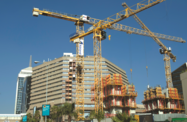A slower-than-expected rollout of major state-backed capital works look likely to weigh on the performance of South Africa’s construction sector up to end-June, with first-half-year results expected to be comparatively modest.
However, the state has prioritised infrastructure development under its strategic development plans and contractors will be hoping that the impact of new legislation and the government’s broader commitment to fast-tracking infrastructure projects will be felt in the third and fourth quarters of 2014 – although budget under-spending has been a challenge in the past, while flood repairs risk eating into allocated funding.
Giving details of South Africa’s 2014 budget in February, the then-finance minister, Pravin Gordhan, said the government planned to spend R847bn ($81.7bn) on infrastructure over the next three years as part of a broader push to increase GDP. The government believes annual economic growth of 5% is required if the country is to tackle unemployment effectively and maintain its development plans.
While the budget put the focus on strengthening South Africa’s transport and electricity networks, facilities in social infrastructure – including the health, education and community sectors – are also due to see an increase in spending of up to 50%, spelling good news for construction firms and contractors.
South Africa’s private sector has no shortage of capacity in terms of handling the expected rise in projects, and has a number of contractors with large international footprints. However, trust will need to be rebuilt between the government and the private sector, following last year’s collusion scandal, which led to the Competition Commission fining 15 construction firms for price-fixing.
Addressing setbacks
The emphasis by the government on infrastructure development bodes well for both the broader economy as well as for contractors, but delays have certainly proved to be a stumbling block for South Africa in previous years. A report released in mid-March by Johannesburg-based financial asset management firm, Stanlib, concluded that government under-spending in recent years had held back infrastructure development and, in turn, the country’s construction sector. While $23.78bn was allocated under the 2012-13 budget for public sector infrastructure spending, only $20.25bn or 85% was used, the report concluded. Some estimates have put the total under-spend for the past six years at more than $27bn.
Kevin Lings, an economist with Stanlib, voiced doubts about how much of an impact infrastructure investment would have on South Africa’s GDP. “Internationally, there is a reasonably clear relationship between increased investment spending and sustained higher GDP growth, with the level of investment ultimately determining the level of employment,” Lings said, in the report. He added that in South Africa, however, “The promise of widespread infrastructural development is proving difficult to keep.”
The government has moved to galvanise the sector, passing the long-awaited Infrastructure Development Bill in late February, a year after it was first tabled.
Challenging times
A boost for the industry would be welcome. While the sector expanded 4.5% in the fourth quarter of 2013 outpacing South Africa’s surprisingly strong annualised economic growth of 3.8% for the same period, a report issued in mid-February by state statistics agency, StatsSA, showed that the industry lost momentum towards the end of the year.
Figures released by StatsSA in a separate March report indicated that the sector shed 8000 jobs in 2013, with most of the redundancies – 7000 – coming in the final quarter. StatsSA said that while many of the job losses were the result of project completion, the flow of new work had failed to soak up the labour pool.
Increasing costs for key materials, exacerbated by the falling rand, have weighed on several industry players, with fuel prices rising 14% in the 12 months to the end of February, according to StatsSA.
Weather woes
Heavy rains and flooding have added to the industry’s troubles, causing delays on building sites across the country in February and March.
According to Norman Milne, president of the South African Forum of Civil Engineering Contractors, the weather led to daily losses of between R50m and R100m ($4.8m-9.6m), with Limpopo, Gauteng, North West, Mpumalanga, KwaZulu Natal and parts of the Free State the worst affected areas.
As Johan van den Heever, the South African Reserve Bank’s head of economic reviews and statistics pointed out on March 12, the impact of the flooding will be felt long after the waters recede. “One can see great expenditures having to be incurred in the next couple of quarters, perhaps, to revive elements of the infrastructure which has fallen behind through this,” he said at a press briefing. Analysts expect at least some of the funds intended for new developments to be channelled, instead, into repair work.
Even with the Infrastructure Development Bill in place, it will take some time to push through the planning and tendering processes on many of the new construction projects. However, if the government succeeds in upping the tempo of its planned developments, the second half of 2014, and beyond, could bring a welcome lift for South Africa’s building industry.
Follow Oxford Business Group on Facebook, Google+ and Twitter for all the latest Economic News Updates. Or register to receive updates via email.

